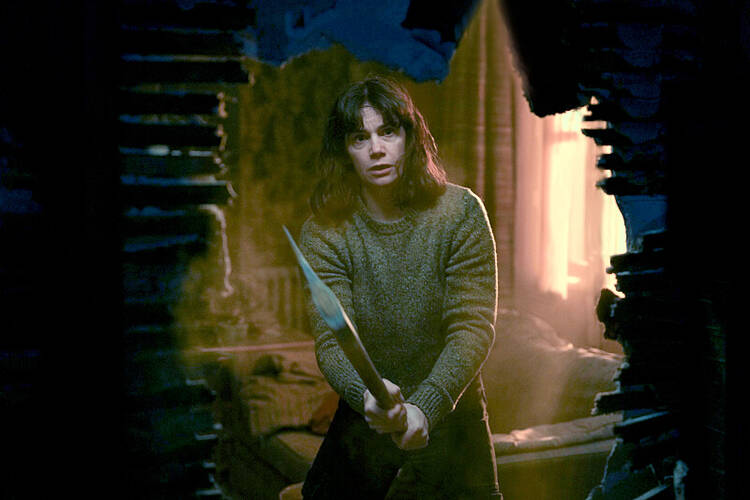When we develop a bruise, we can be tempted to push on that black-and-blue spot—a test to see how much more pain our bodies can take. It’s strange how we almost instinctively, immediately touch the injured area of our bodies, but studies show that touching a bruise, though painful in the short term, can ultimately reduce pain by enhancing the brain’s map of the body.
Lorna Brady is intimately familiar with this paradoxical, self-healing reflex. As the leading character, portrayed by the formidable Ruth Wilson, in the six-episode BBC mini-series “The Woman in the Wall,” Lorna continuously pushes on a deeply traumatic bruise.
Lorna was sent off to a local convent in the fictional town of Kilkinure, Ireland, at the age of 16 when she became pregnant out of wedlock. Run by Catholic nuns across Ireland from the 19th century until the last one closed in 1996, the Magdalene Laundries were for-profit laundries, sometimes called “mother and baby homes,” for “fallen women.” Considered “promiscuous” or financially burdensome to their families, these women were denied education and emotional support, worked amid horrid conditions and faced corporal punishment.
After being separated from their families and newborn children, thousands of women completed hard, unpaid labor in these church-run and state-funded institutions. It is estimated that 10,000 women and girls (a conservative estimate) were forced into these institutions and that an estimated 6,000 babies died in their care.
Kilkinure is a quintessential, thatched-roofed, small town in rural Ireland. The rolling countryside looks as though it has been soaked in a familiar dark stout, evidence of recent floods along the coast. A title card confirms that it is 2015—but the characters’ communicating by flip phone or BlackBerry is evidence enough.
Kilkinure is a quintessential, thatched-roofed, small town in rural Ireland. The rolling countryside looks as though it has been soaked in a familiar dark stout.
The first episode opens with Lorna looking like a crumpled tissue. She has fallen asleep in the middle of a road outside of town and wakes up to cows mooing over her frail body. Wrapped in a tattered nightgown that is stained with blood, she stumbles barefoot down the main street of Kilkinure, greeting her onlookers with indifference or a striking grimace until she reaches her childhood home—the place from which she had been taken years earlier by a local priest, Father Percy Sheehan, while her parents watched through the doorway.
Lorna has been traumatized by the abuse she suffered while working in the laundry, compounded by having her child taken out of her arms shortly after being delivered. She processes these memories in wild, sometimes violent, bouts of sleepwalking. The words ‘STAY AWAKE’ are haphazardly painted on Lorna’s living room door—and the first three episodes are mostly taken up with scenes of Lorna drinking herself into a stupor, fending off sleep and eventually passing into a state of delirium in which she sleepwalks, carrying an ax, and tries to commit arson.
Destabilized by her perpetual grief, Lorna works as a seamstress, one of the few skills she developed in the laundry, afraid of customers and isolated in her own world. But when she receives a note that reads “I know what happened to your child,” with a phone number attached, she begins to press down on her emotional bruise. She receives a text message from the number, telling her to meet at Thin Man’s Pub. But the author of the note never arrives and Lorna wakes up the next morning slumped on the floor of an old storage room in her home with no memory of the night before—only the body of a mysterious woman propped up beside her.
When she receives a note that reads “I know what happened to your child,” with a phone number attached, Lorna begins to press down on her emotional bruise.
Meanwhile, a detective from Dublin, Coleman Akande (played by Daryl McCormack), is looking into the murder of Father Percy, who was posted in Dublin at the time of his death. From here the show begins to weave together its various subplots in a genre-bending format as Coleman begins to suspect Lorna not only of the murder of Father Percy but of knowing of the missing woman whose poster has been posted around Kilkinure.
Is “The Woman In The Wall” a whodunit crime thriller? A historical black comedy? The producer Joe Murtaugh, who crafted the show intending to educate a wide audience about the history of the Magdalene Laundries, has said he hopes it is both.
Lorna’s character balances the audience’s compassion with a bit of her own jester’s privilege. In the first episode, when she arrives home from her sleepwalking, she enters her living room and finds a painting of Jesus with a kitchen knife driven through one eye—an apt representation of Lorna’s severed connection with the church. “That’s not good,” she mutters, yanking the knife from the wall. “Sorry, Jesus.”
Wilson’s performance is simultaneously witty and gripping, but it can feel a bit translucent at times, as though you can see Wilson through the character of Lorna Brady. This is, in part, because of the Irish accent; Wilson is from Surrey, England, and never quite nails a consistent (or convincing) pronunciation of “laundry” and “my child.”
But even where her accent fails, Wilson pulls together a persuasive and raw performance. The tight shots of her dark, weary eyes, whether furiously scanning death certificates or staring down Detective Akande, reveal the depth of her emotion in her microexpressions. Beneath push-broom bangs that are often slicked to her forehead with sweat, the quick twitch of an eye or the perk of an eyebrow reveals the burgeoning spirit of not only a survivor but a fighter.
But even where her accent fails, Wilson pulls together a persuasive and raw performance.
Rumors of who is responsible for the murder of Father Percy swirl around a group of female survivors who are working to have the convent officially recognized as a Magdalene Laundry by the state. This group of female activists—arguably one of the most important components of the historical retelling of the story of the laundries—is somewhat lost amid the murder mystery elements of the series. Most of the historical context for the laundries is given by the uncouth Amy Kane (Hilda Fray), who disparages Lorna’s hopes of ever finding her child through a pursed-mouth sneer as though she is balancing an imaginary cigarette between her lips.
Despite lying to the police, Amy is far more trustworthy than Lorna, whose character seems to be split between her waking and sleeping selves. In his book about trauma entitled The Body Keeps Score, Bessel van der Kolk writes” “As long as you keep secrets and suppress information, you are fundamentally at war with yourself. The critical issue is allowing yourself to know what you know. That takes an enormous amount of courage.”
Eventually, through a partnership with Detective Akande, Lorna does let herself know—openly sharing the memories of the brutal trauma she endured—though she first goes through an internal war to resist that knowing. Her memories, presented as striking flashbacks, draw her out of the present; she seems to disappear into a memory mid-conversation whenever she speaks to a fellow survivor. From sleepwalking barefoot through town to pouring hot sauce in her eyes before her police interrogation to lighting a cigarette with a blowtorch, Lorna is a maverick, and Wilson’s portrayal, which is anything but low-key, outshines that of her fellow cast members.
The entire show feels cast in a murky hue, some scenes so dark that you cannot see anything but the outlines of characters lurking. Sometimes viewing the video screen—even when set to full brightness—is like staring into a black abyss. From the bluish rainy scenes in the streets of Kilknure to the reddish-purple glow of the storage room of Lorna’s home, the images almost bring us inside Lorna’s bruise, pushing at the boundaries of her pain threshold with her.
Does pushing on the bruise ultimately help to heal? For Lorna, it seems that way.
The portraits of the religious sisters carry this same kind of painful discomfort. In Episode 4, Sister Eileen (Francis Tomelty), the mother superior at the Kilkinure laundry, emerges from the shadows in the convent where Lorna is searching for a death certificate. Sister Eileen asks, bitingly: “You think because you gave birth, that makes you a mother? Motherhood has to be earned, girl.” Lorna tries to retaliate, but Sister Eileen’s words echo within her: “You never had a daughter.” The bruise deepens.
Unfortunately, the solution to the central question of this whodunit feels unconvincing and hollow. I won’t give any spoilers, but rather advice for the viewer: Take the show’s title literally. (And try not to get too spooked by the electronic choral music that haunts the early episodes.)
Does pushing on the bruise ultimately help to heal? For Lorna, it seems that way. Search beyond the subpar dramaturgical murder mystery plot points and find Lorna’s blooming battle cry for the women of the laundries. “The Woman in the Wall” is worth the watch, if only for the history lesson.
And if not for that, then at least for the debut of Sinead O’Connor’s unreleased song, “The Magdalene Song,” which was recorded shortly before her death. The credits roll as she sings, “I’m everything a woman’s not supposed to be/ That’s why they took my children off of me.”
“The Woman in The Wall” is now streaming on Paramount+








